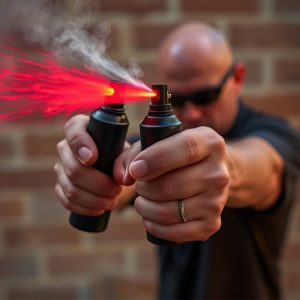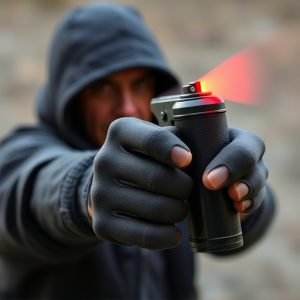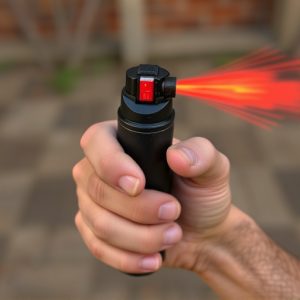Pepper Spray Holster Safety Tips: Police-Grade Composition and Effective Use
This text emphasizes the Pepper Spray Holster Safety Tips for both personal and law enforcement user…….
This text emphasizes the Pepper Spray Holster Safety Tips for both personal and law enforcement users. Key points include:
Secure storage: Choose holsters with secure locking mechanisms to prevent accidental discharge, especially for police-grade sprays with higher capsaicin concentrations.
Training: Users, particularly law enforcement, must be trained in proper deployment techniques targeting vulnerable areas while maintaining safe distances to minimize risks.
Regulatory Compliance: Understand local laws regarding possession and use, store pepper spray responsibly (away from children, heat sources, etc.), and never aim at anyone unless in a self-defense situation.
Holster Maintenance: Regularly inspect holsters for damage or wear, replacing them as needed to ensure reliability.
“Discover the power of police-grade inflammatory pepper spray compounds, a crucial tool for personal safety. This comprehensive guide explores the intricate chemistry behind these potent agents, highlighting key differences between police-grade and standard varieties. We delve into the art of choosing the right pepper spray holster, emphasizing fit and functionality. Additionally, our article offers vital safety protocols for responsible carrying, ensuring effective deployment in legitimate use cases. Empower yourself with Pepper Spray Holster Safety Tips for confident, lawful protection.”
- Understanding Pepper Spray: The Chemical Composition
- Police Grade vs Standard Pepper Spray: Key Differences
- Choosing the Right Pepper Spray Holster: Fit and Functionality
- Safety Protocols When Carrying Pepper Spray: Best Practices
- Effective Use Cases: When to Deploy Pepper Spray Legally
Understanding Pepper Spray: The Chemical Composition
Pepper spray, a powerful tool for law enforcement and self-defense, is a complex compound designed to incapacitate individuals temporarily through irritation and pain. The active ingredient in most pepper sprays is capsaicin, a chemical derived from chili peppers. This substance is often referred to as the ‘heat’ in pepper spray, causing a burning sensation when it comes into contact with mucous membranes.
When carried in a holster, pepper spray requires proper safety tips to ensure both user and bystander protection. Understanding the chemical composition is key; capsaicin is highly potent and can remain active for extended periods. Holsters should be designed to prevent accidental discharge, often featuring secure locking mechanisms. Users must also be trained in its responsible use, aiming for eyes and face areas, where capsaicin’s effects are most severe, ensuring a safe distance from others during application.
Police Grade vs Standard Pepper Spray: Key Differences
Police-grade pepper spray is designed for professional law enforcement use and is significantly more potent than standard, commercially available pepper spray. While both types aim to incapacitate a subject through irritation and pain, police-grade compounds contain higher concentrations of capsaicin, the active ingredient responsible for the burning sensation. This increased potency makes it more effective in high-stress situations, ensuring officers have the necessary force to control and subdue individuals.
When it comes to safety tips for carrying pepper spray holsters, understanding these differences is crucial. Police-grade sprays require more caution due to their strength, often requiring specific training and protocols for proper use. In contrast, standard sprays might be suitable for personal defense or recreational activities, where a lesser concentration can provide a deterrent without causing prolonged harm. Always follow local regulations and seek advice from professionals when choosing and using pepper spray, especially when considering police-grade options.
Choosing the Right Pepper Spray Holster: Fit and Functionality
When selecting a pepper spray holster, ensuring both fit and functionality is paramount for optimal safety and effectiveness. The right holster should securely hold your pepper spray device, allowing easy access during an emergency while preventing accidental discharges. Consider factors such as the size and weight of your chosen pepper spray compound—a well-fitted holster tailored to your specific model guarantees a firm grip, minimizing the risk of drops or misplacements.
For enhanced safety tips, opt for holsters featuring additional security measures like locking mechanisms or durable materials that withstand harsh conditions. Regularly inspect your holster for any signs of wear and tear, promptly replacing it if necessary. By prioritizing these factors, you not only enhance the reliability of your pepper spray but also boost your personal safety during potentially dangerous situations.
Safety Protocols When Carrying Pepper Spray: Best Practices
When carrying pepper spray, adhering to strict safety protocols is paramount. Always keep it in a dedicated holster designed for this purpose, ensuring it’s easily accessible yet secure. The holster should fit comfortably and allow for swift deployment when needed. Regularly inspect the spray for any signs of damage or expiration, as these can compromise its effectiveness. Understand your local laws regarding pepper spray possession and use; knowledge of these regulations is crucial to avoid legal repercussions.
Best practices include storing the spray out of reach of children and pets, away from heat sources, direct sunlight, and other extreme conditions that could affect its performance. Never point or aim it at anyone unless in a self-defense situation, as this could lead to accidental exposure or misuse. Always keep it in a cool, dry place, and never leave it unattended in public areas. Regular training on usage is essential to ensure you’re familiar with the spray’s mechanics and can employ it safely and effectively when required.
Effective Use Cases: When to Deploy Pepper Spray Legally
Pepper spray is a powerful tool that, when used legally and appropriately, can be an effective deterrent in various situations. It’s crucial to understand the specific circumstances under which its deployment is not only permissible but also ethically sound. Law enforcement agencies often rely on pepper spray during high-risk encounters, such as when dealing with aggressive or violent individuals who pose a threat to public safety. For instance, in a situation where an armed suspect refuses orders to surrender and advances towards officers, a well-placed burst of pepper spray can temporarily incapacitate the individual, allowing for safer resolution of the incident.
When considering Pepper Spray Holster Safety Tips, it’s essential to remember that its use should always be a last resort. It is particularly useful in crowd control scenarios where non-lethal force is required to disperse rioters or protesters who resist arrest or engage in destructive behavior. However, officers must be trained to employ pepper spray judiciously, ensuring minimal harm to bystanders and adhering to the legal guidelines governing its use in their jurisdiction.
In conclusion, understanding the chemical composition of pepper spray, recognizing key differences between police-grade and standard varieties, choosing the right holster for optimal fit and functionality, adhering to safety protocols, and knowing legal deployment scenarios are essential aspects of responsible pepper spray ownership. By following these Pepper Spray Holster Safety Tips, individuals can ensure its effective and safe use while staying within legal boundaries.


